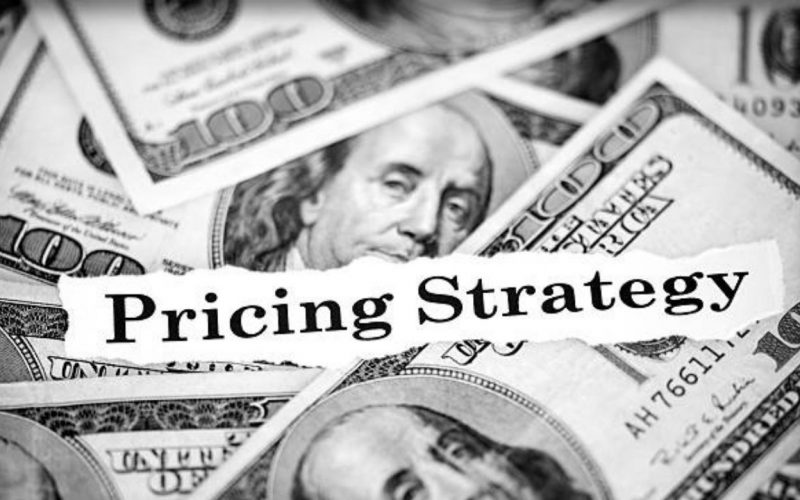It’s no secret that businesses are critical to a country’s economy. While many variables can influence a company’s income potential, one of the most crucial is its owners’ Pricing Strategy.
A good pricing plan will assist you in determining the price point at which you can maximize earnings on product or service sales. A business owner must examine a variety of elements when determining prices, including production and distribution expenses, rival products, positioning strategies, and the intended consumer base.
Customers will not buy excessively expensive things, but your business will fail if you price goods too low to meet all of your costs. Price, in addition to product, location, and promotion, can have a significant impact on the success of your small business.
As you progress in reading, you will learn about some of the ways that businesses use to set prices for their products and services and how you can best strategies to Maximize profit.
What is Pricing Strategy?
Price is the monetary worth assigned to a product or service, and it is the result of a complex combination of calculations, research, and comprehension, as well as the ability to take risks. Segments, ability to pay, market conditions, competitor actions, trade margins, and input costs are all factors that go into a pricing strategy. It is aimed at a certain set of clients as well as competitors.
Too many companies set their prices without giving them any attention. This is a mistake that has resulted in their leaving money on the table from the start. The good news is that taking the time to properly price your products may be a great growth tool. If you optimize your pricing so that more customers pay a higher price, you’ll make a lot more money than if you just set prices without much thought. This may seem self-evident, yet organizations rarely devote significant resources to determining the appropriate pricing strategy.
What are the Major Pricing Strategies?
Depending on the industry and business model, value-based, competition-based, cost-plus, and dynamic pricing are all common pricing strategies.
Wha is Price Strategy Structure?
A pricing structure is a method by which the costs of your company’s goods and services are specified and made clear to customers. The goal is to set prices that are consistent with your pricing strategy while making a profit and charging no more than the market will bear.
Best 7 Pricing Strategies for Businesses
Here are the various types of pricing strategies for any business to adopt:
- Competition-based pricing
- Cost-plus pricing
- Dynamic pricing
- Economy pricing
- Value-Based Pricing
- Time-based pricing
- Price Skimming
#1.Competition-based pricing
Competition-based pricing uses pricing data for similar products from competitors to establish a base price for their own products. This pricing strategy largely relies on market data rather than focusing on production costs or the item’s value.
Consider it this way: You have five competitors who sell the same product as you, and you divide them into five categories, ranging from the most expensive to the most economical. Then you have to figure out where you fit in. Also read: Competitive Pricing: How to do Competitive Pricing Analysis
When to use competition-based pricing
Companies rely on competition-based pricing for a simple reason. It’s simple, and you have total control over your market share. Market data on competitors can provide more than just pricing insights, which you can use to recreate similar results in your own business.
The downsides include that it is difficult for businesses to survive just on low prices if they are not actively adding value to their customers’ lives and do not produce a high-quality product. One of the most common errors is selling purely based on a competitor’s pricing, which can devalue your product and cost you money. Retailers and small enterprises, in particular, can benefit greatly from competitive pricing.
#2. Cost-plus pricing
Cost-plus pricing is a simple pricing method that works by taking the whole cost of manufacturing a product and adding a markup to it to determine the price. In the long run, this is a sound plan.
A business owner must first comprehend the costs of manufacturing, which include materials, labour, warehousing, machinery, utilities, and other expenses. The profit is calculated by adding a markup price to the top of the production cost.
#3.Freemium
The term “freemium” comes from a combination of the words “free” and “premium,” and it refers to a business model in which you provide a free version of your product or service before upselling people to a paid version.
This concept is used by the music streaming company Spotify, which offers a free version that allows users to listen to music but requires them to upgrade to a paid account if they wish to save files to listen to offline, skip tracks indefinitely, or modify their audio quality.
Freemium can be used to break into new markets or introduce new items as part of your go-to-market strategy.
Slack has enjoyed remarkable success with a 30 per cent conversion rate because of its freemium strategy. Also read: Premium Pricing Strategy: Overview & Detailed Example
#4. Economy pricing
This is a prevalent tactic in the commodity goods industry. The idea is to undercut the competitors on price and recoup the difference through increasing volume. It’s a good way to convince people to buy your generic drink, but it’s not ideal for SaaS and subscription businesses.
#5. Value-Based Pricing
Value-based pricing is a pricing strategy that bases costs on the value customers derive from a product or service, rather than the cost of production.
This method works best when your product or service is unique and cannot readily be replaced.
The early years of iPhones are a great example of this: the cost of manufacturing the phones is significantly lower than the market price, but because no other smartphones had similar functionality at the time, Apple was able to set a high price and establish what the “value” of touch screen smartphones was.
When your product or service is much superior to alternatives that can perform the same job, value-based pricing can be applied.
The true cost of production for software development, for example, is basically the developer’s minimum wage plus the cost of the equipment and software used in the development process. App programmers, on the other hand, get paid more since they have a highly sought-after skill set, and paying someone else to perform the task is more effective and efficient than learning to code and attempting to build an app on your own.
#6. Time-based pricing
Companies that have a product or service with significant seasonality or last-minute orders generally utilize a time-based pricing strategy.
Airlines are a good example of this: booking flights during peak seasons is more expensive, but going during off-seasons is less expensive. Furthermore, the closer you book to the departure date, the more expensive the ticket.
You’ll need a system in place to track the elements at play and modify prices accordingly for time-based pricing to succeed, especially if consumers can purchase without speaking with sales.
A transcription firm, for example, may charge more for same-day transcription than for a document transcribing within a week. The pricing is greater because of the quick turnaround.
#7. Price skimming
Price skimming is a strategy used by businesses to increase sales of new products and services by setting rates high during the initial phase. As new competitors enter the market, the corporation steadily cuts pricing.
Price skimming has the advantage of allowing businesses to maximize earnings on early adopters before decreasing prices to attract more price-sensitive customers. When your product is first presented on the market, price skimming not only helps a small business recoup its development expenditures but also gives the impression of quality and exclusivity.
Also read: Pricing Strategies: Top 7 Examples of Pricing Strategies
Importance of Pricing Strategy
- Right Level Pricing
- Price Creates First Impression
- Vital Element of Sales Promotion
- Flexible Element of Marketing Mix
>. Right Level Pricing
A company’s demise can be precipitated by a poor price decision. It’s critical to set pricing at the proper level after thorough market research and consideration of aspects such as rivals’ strategies, market conditions, production costs, and so on.
Low prices may initially attract clients, but it will be difficult for the company to raise prices in the future. Very high pricing, on the other hand, will result in higher profit margins but lower sales. It is therefore critical to set the proper pricing in order to maintain a balance between profitability and sales volume.
>.Price Creates First Impression
A customer’s first impression of a product is frequently based on its price. A customer may decide to buy a product based on its overall benefits, but he is more likely to compare the price to how much he thinks the product is worth. Customers want to know more about the product’s qualities after knowing about the price.
If a product is overpriced, the customer may lose interest in learning more about it. However, if he believes a product is affordable, he will strive to learn more about it. As a result, pricing is an important component in a buyer’s decision.
>. Vital Element of Sales Promotion
Price is the most essential portion of the sales promotion since it is the most changeable component of the marketing mix. The marketing manager may lower the price to attract more sales. If the demand for a product is price sensitive, even a little price cut will result in increased sales volume. Prices, on the other hand, should not be changed regularly in order to stimulate sales.
>. Flexible Element of Marketing Mix
The most malleable part of the marketing mix is price. In comparison to other aspects such as product, location, or promotion, prices can be modified quickly. It would take a long time to apply changes to the product design or distribution system.
Changing adverts or promotional activities is a time-consuming effort as well. However, the pricing is extremely flexible and can be adjusted to meet the needs of the circumstance. As a result, it is an essential part of the marketing mix.
Pricing Strategy Marketing
Marketing is both a science and an art. Pricing is a marketing function as well. You must actively manage your customer connections in order to recruit new customers, raise CLV (customer lifetime value) over time, and reduce customer turnover.
Considered pricing and packaging are some of the most significant tools you have for creating and monetizing your client connections, and marketing must play a key role in this process. Dynamic pricing is necessary. Furthermore, the significance of your pricing approach in marketing cannot be overstated.
When it comes to marketing things, “cost-plus” pricing is common. To put it another way, the product costs you a specific amount to manufacture and sell (whether this includes actual manufacturing or just development expenditures), and you set a price that is higher than the cost to earn a profit margin. Your rates may be reduced depending on how many things you can sell (and margins lower).
However, business models are evolving, and with them, effective pricing tactics. We now live in a subscription-based world, where customers don’t just want to buy items. They demand the services and features they desire, when and how they desire them. So, how do you price something like that?
Simply said, pricing under a subscription model may be thought of as three-dimensional: how much you charge, for what, and for how long. Customers are charged for their consumption and the value they receive from your service, therefore pricing is dependent on usage. Packaging is strategic in that it combines elements into a single product and charges accordingly.
Offering a free trial or freemium version of your business is one strategy to attract users for a low marketing expense. Neither model is clearly superior; it all relies on your specific business and market. Also read: Entrepreneur Life: 5 Strategies to Guarantee Success
What is Price Barrier?
A price barrier is a level of price at which a large number of investors buy or sell shares.
What is Price Policy?
A pricing policy is a company’s method to determining the market price for a good or service. Pricing rules help businesses maintain profitability by allowing them to sell various products differently.
What Strategies Are Used for Pricing Products?
Here are strategies to use in pricing your product:
- Simply calculate your costs and apply a mark-up to arrive at cost-plus pricing.
- Setting a price based on what the competitor charges is known as competitive pricing.
- Setting a price based on how much the client believes what you’re selling is worth is known as value-based pricing.
What Is the Best Price Strategy for Your Product?
It’s important to think about which of these price techniques will help you achieve your pricing goals. Aligning pricing and value is an important consideration. You can’t expect to make a profit by selling a valuable product at an unreasonably low price. Similarly, no one will pay too much for a product they don’t believe is worth it.
Conclusion
The aforementioned tactics are the most widely used by organizations to maximize profit on their product or service sales.
Every pricing plan is successful in its own right. So, before deciding on a pricing plan for your product or service, consider your market position as well as other factors to get the most out of the strategy.
As a result, knowing your competitive position is crucial when deciding on pricing. What your clients or customers expect in terms of price should be factored into the marketing mix.
To be a leader in today’s highly competitive climate, businesses must capture the full value of their product lines across their entire life cycle and through different distribution channels. Because pricing is a tactic that is underutilized, it provides fertile ground for new earnings.
FAQs On Pricing Strategy
What are the methods of pricing?
The best method of pricing are:
- Value-based pricing
- Competitive pricing
- Price skimming
- Cost-plus pricing
- Penetration pricing
- Economy pricing
- Dynamic pricing
How do you achieve competitive pricing?
The process of determining key price points to best take advantage of a product or service based market relative to the competition is known as competitive pricing.






